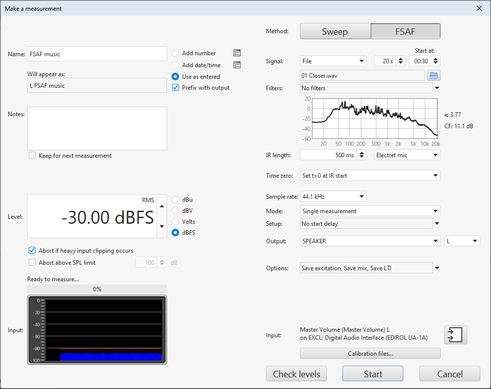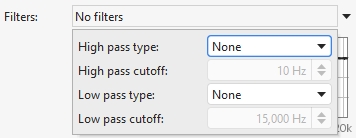 (or Ctrl+M) to bring up the Measure dialog and select the
FSAF method
(or Ctrl+M) to bring up the Measure dialog and select the
FSAF method



REW can make loudspeaker measurements using the Fast Subband Adaptive Filtering process developed by Michael Tsiroulnikov aka Michael Zrull. See Michael Zrull (2020) Fast Subband Adaptive Filtering (FSAF) www.mathworks.com/matlabcentral/fileexchange/83363-fast-subband-adaptive-filtering-fsaf and Michael Tsiroulnikov (2022). Loudspeakers for AEC: Measurement and Linearization www.mathworks.com/matlabcentral/fileexchange/117715-loudspeakers-for-aec-measurement-and-linearization. The MATLAB code is Copyright (C) 2001-2024 MICHAEL ZRULL (TSIROULNIKOV). All rights reserved. Direct or indirect commercial derivatives or usage prohibited. It was released under the GNU General Public License v.3+ www.gnu.org/licenses.
The source code for the Java port is on Github.
REW's FSAF implementation can use noise (white, pink, brown) or a segment of a user-supplied file as the measurement signal, allowing distortion results (TD+N) to be obtained when playing back music. a 10 Hz first order high pass filter is applied to the input signal before FSAF processing to avoid processing artefacts.
Note that when using a file as the measurement signal any defects in the file, such as clipping, will increase measured TD+N. Clipped data in files typically causes clicks in the distortion residual.
FSAF processing is very sensitive to clock rate differences between replay and record. The best results are obtained when using the same audio interface for both output and input, so there is only one clock source. If the input and output devices are different REW can use timing markers before and after the measurement signal to apply clock rate correction. Even with rate correction applied the results are heavily affected by the stability of the clock sources. USB microphones which rely on the USB clock are not suitable for FSAF measurement as the USB clock is not stable. That means, for example, UMIK-1, UMM-6 and Omnimic are unsuitable for FSAF measurements. It is possible to use a USB mic which has an internal clock source, such as UMIK-2.
The self-noise and distortion of the microphone used will also be reflected in the results. Microphones using low cost 6mm electret omni capsules typically have high noise levels, low maximum SPL and rapidly rising distortion at higher SPL. High quality measurement microphones are better but expensive, a lower cost alternative is the Line Audio Design Omni1, which uses a 10 mm capsule, but has limited global distribution. Another option is to use a ½" cardioid condenser microphone, such as the AKG P170. However, it will be necessary to generate a frequency response calibration file for such a microphone by the substitution method, using a calibrated measurement microphone as a reference and making sweep measurements of their responses. Cardioid microphones also suffer from proximity effect, meaning their low frequency response is affected by their distance from the source, which must also be taken into account. That can be done by making the substitution calibration measurements with the same loudspeaker and mic positions as will be used when making the loudspeaker measurements.
To ensure the microphone calibration file is applied to the FSAF distortion results make sure the Apply cal files to distortion option is selected in the REW Analysis preferences.
 (or Ctrl+M) to bring up the Measure dialog and select the
FSAF method
(or Ctrl+M) to bring up the Measure dialog and select the
FSAF method



The FSAF distortion results are available on the Distortion graph, showing the input spectrum, the noise spectrum captured before the measurement begins and total distortion + noise (TD+N).
When using a file as the test signal REW may optionally save a copy of the measurement residual (the difference between the measured and linear response) in the mdat file. There are also options to also save the excitation, mic input and LTI response as WAV files. The default location for those WAV files is the temp sub-folder of the REW log files folder, whose location is shown in the About REW box. WAV files in the temp folder are deleted after 7 days. The folder location can be changed using the Set FSAF folder button in the Distortion graph controls. The residual files have names starting "res-" followed by the UUID of the measurement.
The residual (if it was saved) can be played back in the default player for WAV files by using the Play FSAF residual button in the Distortion graph controls. The Gain control allows the residual to be scaled up to help audibility, REW will automatically limit the gain applied to ensure the residual does not clip.
The residual can be loaded as audio data by using the Load FSAF residual button in the Distortion graph controls. It can be saved as a WAV file by using the Save FSAF residual button.